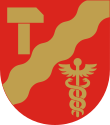
Moomin Museum is situated in the city of Tampere, Finland. Shown at the Moomin Museum are illustrations by Tove Jansson, 40 miniatures, tableaux about Moomin events and a small Moomin House. There are about 2,000 exhibits on display. Also shown is the original Moominvalley multimedia. The Moomin Shop sells gift items and the Moomin Library offers Moomin books in many languages.
Tampere University is a multidisclipinary public university located in the city of Tampere, Finland. It is the second largest university in the country by student enrollment.

Amuri is a district in the city of Tampere, Finland.
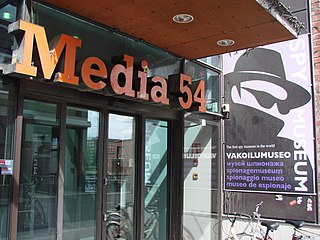
The Spy Museum is the world's first public museum of international espionage, located in Tampere, Finland. The museum was founded in 1998. The idea of the museum was invented by Teppo Turja, who founded the museum. The museum is the only one of its kind in Europe, besides Spy Museum Berlin.

Hämeenpuisto is a street and public park in Tampere, Finland that is over 1-kilometre (0.62 mi) in length. Its length and central location has earned the park the name "Central Park of Tampere". The park was designed by Carl Ludvig Engel in 1830. Originally the name of the park was Esplanadi, which was changed to Hämeenpuisto in 1936.

The Finlayson Church is a church built in Gothic Revival style located in the Finlayson industrial area in the district by the same name in Tampere, Finland. It was built in 1879 as the church of the Finlayson cotton factory, where the factory workers could practice religion. Currently the church belongs to the Evangelical-Lutheran congregations of Tampere, and it is used as a children's road church and a popular church for weddings.
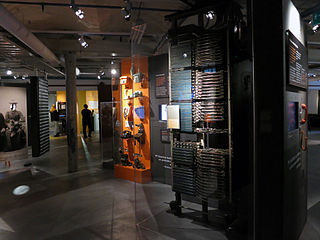
The Rupriikki Media Museum is a history museum devoted to mass communication. It is located in the Vapriikki Museum Centre, in Tampere, Finland. Rupriikki showcases media history. Collections include cellular phones, radios, telephones, computers, and press materials.

Pyynikki is a district and a nature reserve in Tampere, Finland. It is located in the Pyynikinharju ridge, between the city center and the western district of Pispala. Pyynikinharju is the highest esker in the world, rising 85 meters above the level of lake Pyhäjärvi.

Tampella is a neighbourhood in the northern part of the city center of Tampere, Finland. It consists of the old Tampella factory area, the Armonkallio residential area and the Naistenlahti harbor area. The neighboring parts of the internally heterogeneous district located on the shores of Lake Näsijärvi are Lapinniemi, Lappi, Osmonmäki, Tammela, Jussinkylä, Finlayson and Särkänniemi.

Keskusta is a main district of the city of Tampere, Finland, formed by less than 20 suburbs in the city centre. Over 63,000 people live in Keskusta. It is located along the Tammerkoski rapids and its most important services include Tampere City Hall and the Market Hall.

Tammelantori is a market square in the Tammela district in the center of Tampere in Pirkanmaa, Finland. It is one of Tampere's most significant marketplaces, which is very popular, especially during the summer. The market is very famous for its cafes and mustamakkara kiosks.

Hatanpää Manor was a manor in the area of the current city of Tampere on the shores of Lake Pyhäjärvi in Pirkanmaa, Finland. It was founded in the 1690s, but the current main building of Hatanpää Manor, designed by architect Sebastian Gripenberg, was completed in 1885. The manor has preserved the manor park on the Hatanpää's peninsula, as well as the main building and villa building built in the late 19th century. The former land areas of the manor are now residential and industrial areas.
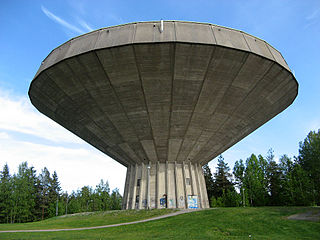
Tesomajärvi is a district in the southwestern part of Tampere, Finland, belonging part of Tesoma's planning area. 1,280 people lived on Tesomajärvi in 2015. Although the population of Tampere is growing, the population of Tesomajärvi has clearly decreased from about 1,500 in 1996. The districts surrounding Tesomajärvi from the south clockwise are Rahola and Ristimäki, Kalkku, Ikuri, Haukiluoma, Lamminpää, Tohloppi and again Ristimäki. Tesomajärvi is one of Tampere's regional centers. In addition to Ristimäki, most of the commercial and public services in the Tesoma area are located in the district. In addition, the district includes the Tesoma's indoor swimming pool and ice rink.

Näsilinna is a neo-baroque palace on Näsikallio in Tampere, Finland. It was built by Peter von Nottbeck, son of Wilhelm von Nottbeck, a St. Petersburg-based industrial manager of Finlayson. The original name of the palace, completed in 1898, was Milavida. The building was designed by architect Karl August Wrede. The true meaning and history of the name Milavida is unknown.

Lentävänniemi is a district in the western part of Tampere on the shores of Lake Näsijärvi in Pirkanmaa, Finland. It belongs to the northwestern part of the city and borders the Niemi and Niemenranta borders on the southwest. There are jogging paths along the lake and its shores surrounding the apartment-based Lentävänniemi. In 2014, the population of Lentävänniemi was 4,309.

The Tampere Central Fire Station is a fire station located at Satakunnankatu 16 in the Jussinkylä, Tampere, Finland, on the eastern shore of Tammerkoski. The Art Nouveau-style fire station building, completed in 1908, was designed by architect Wivi Lönn.

Posteljooninpuisto is a French formal garden style park built in the 1930s in central Tampere, Finland, at the corner of Rautatienkatu and Itsenäisyydenkatu. At the corner of the park is the former head post office of Tampere. The park is also internally connected to the Tampere railway station located next to it, which the Finnish Heritage Agency has classified as a significant cultural environment. The park is owned by the city of Tampere.
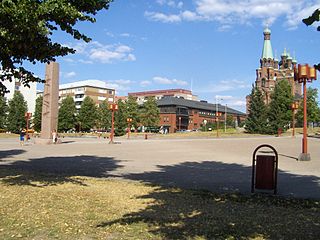
The Sori Square is a square located in the center of Tampere, Finland, in the southern part of the Kyttälä district. It is located in the area bounded by the Hatanpää Highway, Suvantokatu, Tuomiokirkonkatu and Vuolteenkatu. At the eastern end of the square is the Tampere Orthodox Church from 1898. There is a terminus at Tampere Tram Line 1 on the west side.
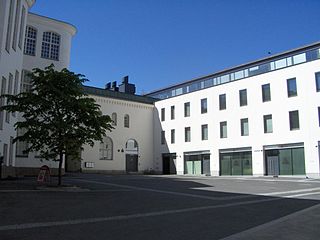
The Väinö Linna Square is a courtyard-type square at the Finlayson's old factory area in Tampere, Finland. It is part of the Tammerkoski rapids' industrial landscape, which in 2009 was classified by the Finnish Heritage Agency as a nationally significant built cultural environment. Today, the buildings surrounding the square include the Werstas Labour Museum and Mehiläinen Private Hospital. The oldest building in the square is the six-storey old factory called Kuusivooninkinen (1837), which was Finland's first modern factory building. In 1995, the square was named after Väinö Linna, who formerly worked in that building and was later known as a very significant writer.

The Tampere Police Station is a police station located in the Ratina district in Tampere, Finland, and also the administrative center of the Central Finland Police Department. The police station is also used by the Finnish Security Intelligence Service (SUPO). There are about 400 police officers working there and about 50 others. The police station consists of two buildings located near the Tampere Bus Station along the Hatanpää Highway and Sorinkatu streets; due to this, in Tampere colloquially, the police station and its surroundings are also known as Sori by locals.

